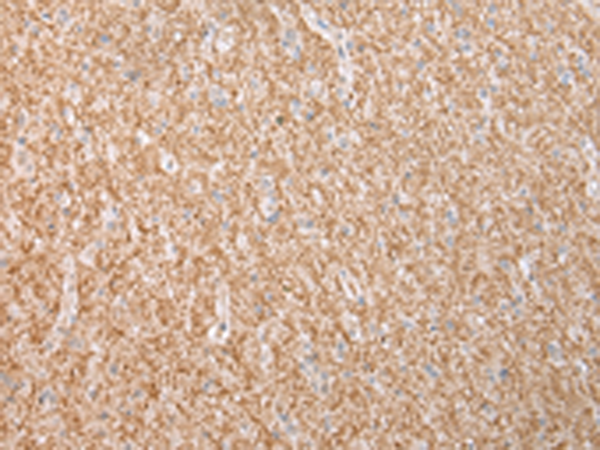
| WB | 咨询技术 | Human,Mouse,Rat |
| IF | 咨询技术 | Human,Mouse,Rat |
| IHC | 1/25-1/100 | Human,Mouse,Rat |
| ICC | 技术咨询 | Human,Mouse,Rat |
| FCM | 咨询技术 | Human,Mouse,Rat |
| Elisa | 1/2000-1/5000 | Human,Mouse,Rat |
| Aliases | MMD1; FER1L1; LGMD2B |
| Host/Isotype | Rabbit IgG |
| Antibody Type | Primary antibody |
| Storage | Store at 4°C short term. Aliquot and store at -20°C long term. Avoid freeze/thaw cycles. |
| Species Reactivity | Human, Mouse |
| Immunogen | Synthetic peptide of human DYSF |
| Formulation | Purified antibody in PBS with 0.05% sodium azide and 50% glycerol. |
+ +
以下是关于DYSF(Dysferlin)抗体的3篇参考文献及其摘要概括:
1. **文献名称**:*Dysferlin deficiency in mice leads to impaired membrane repair and progressive muscle dystrophy*
**作者**:Bansal D, et al.
**摘要**:该研究通过构建Dysferlin缺陷小鼠模型,发现其肌肉细胞因膜修复功能缺失导致肌营养不良表型。研究使用特异性DYSF抗体进行免疫印迹和免疫组化,证实了Dysferlin蛋白在正常肌肉中的定位及缺陷小鼠中的完全缺失,为理解肢带型肌营养不良2B型的病理机制提供了依据。
2. **文献名称**:*Characterization of monoclonal antibodies to dysferlin for diagnostic application*
**作者**:Anderson LV, et al.
**摘要**:作者开发了多种针对Dysferlin的单克隆抗体,并验证其在患者肌肉活检中的诊断价值。通过比较不同抗体在免疫染色中的表现,确定了高特异性的抗体组合,显著提高了肌营养不良亚型分类的准确性,尤其适用于LGMD2B和Miyoshi肌病的鉴别诊断。
3. **文献名称**:*Autoantibodies against dysferlin in inflammatory myopathies: A potential diagnostic biomarker*
**作者**:Uruha A, et al.
**摘要**:研究发现部分炎症性肌病患者血清中存在抗Dysferlin自身抗体,可能与继发性肌肉损伤相关。通过ELISA和蛋白质印迹分析,揭示了这类抗体与疾病活动性的相关性,提示DYSF抗体检测在区分遗传性和获得性肌病中的潜在临床意义。
Dysferlin (DYSF) is a calcium-regulated transmembrane protein predominantly expressed in skeletal muscle and involved in membrane repair, vesicle trafficking, and myogenesis. Mutations in the DYSF gene are linked to rare autosomal recessive muscular dystrophies, including limb-girdle muscular dystrophy type 2B (LGMD2B) and Miyoshi myopathy. These disorders are characterized by progressive muscle weakness, elevated serum creatine kinase levels, and histopathological features like inflammatory infiltrates and necrotic fibers. Dysferlin deficiency disrupts sarcolemmal repair mechanisms, leading to chronic muscle damage.
DYSF antibodies are essential tools for studying dysferlin's role in muscle biology and disease pathogenesis. They are widely used in diagnostic immunohistochemistry (IHC) and Western blot analyses to confirm dysferlin deficiency in patient biopsies, differentiating LGMD2B from other muscular dystrophies with overlapping clinical features. Commercially available monoclonal and polyclonal antibodies target specific epitopes of the dysferlin protein, enabling researchers to investigate its expression patterns, subcellular localization, and interactions with partners like caveolin-3 or annexins. Recent studies also explore the therapeutic potential of antibody-mediated strategies, such as exon-skipping or gene therapy validation. However, variability in antibody specificity and cross-reactivity with homologous proteins (e.g., myoferlin) necessitates careful validation in experimental models. Ongoing research aims to refine antibody-based diagnostics and develop targeted therapies for dysferlinopathies.
×